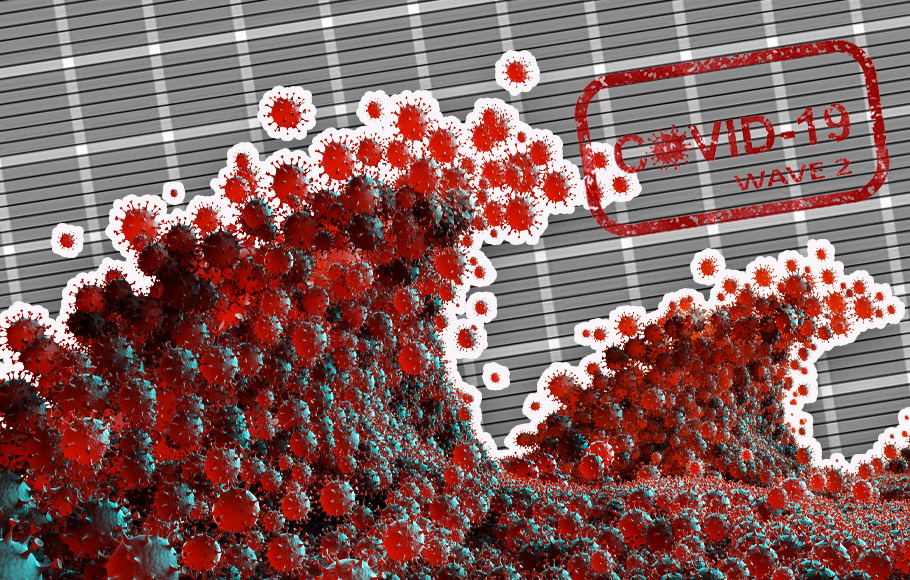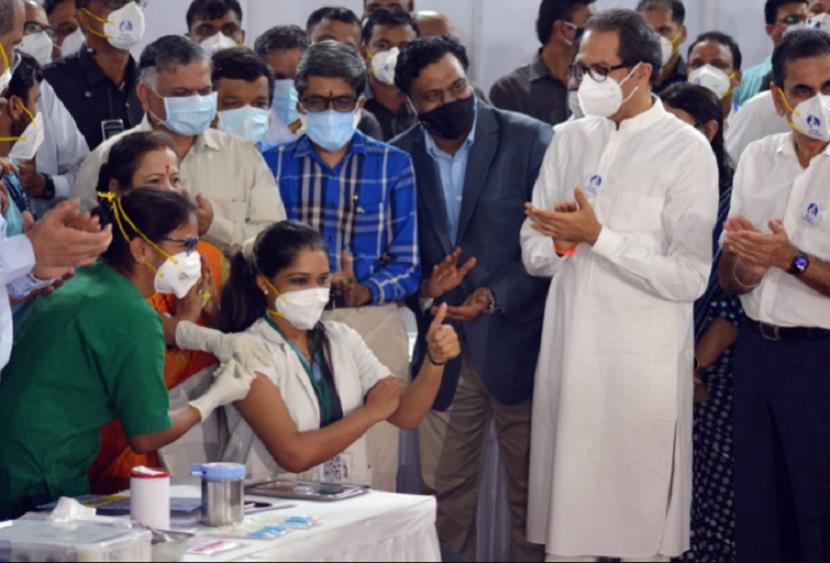
- Home
- News
- Analysis
- States
- Perspective
- Videos
- Education
- Entertainment
- Elections
- World Cup 2023
- Features
- Health
- Business
- Series
- Economy Series
- Earth Day
- Kashmir’s Frozen Turbulence
- India@75
- The legend of Ramjanmabhoomi
- Liberalisation@30
- How to tame a dragon
- Celebrating biodiversity
- Farm Matters
- 50 days of solitude
- Bringing Migrants Home
- Budget 2020
- Jharkhand Votes
- The Federal Investigates
- The Federal Impact
- Vanishing Sand
- Gandhi @ 150
- Andhra Today
- Field report
- Operation Gulmarg
- Pandemic @1 Mn in India
- The Federal Year-End
- The Zero Year
- Premium
- Science
- Brand studio
- Home
- NewsNews
- Analysis
- StatesStates
- PerspectivePerspective
- VideosVideos
- Entertainment
- ElectionsElections
- Sports
- Loading...
Sports - Features
- BusinessBusiness
- Premium
- Loading...
Premium

The second wave, emerging variants and the vaccines
After nearly a year of worldwide spread, infecting about 127 million causing 2.78 million deaths, the COVID-19 pandemic was appearing to recede during the first two months of 2021. However, COVID cases started to spike alarmingly during March this year in India, ranking it again third after the USA and Brazil among countries with COVID cases.

“Yes, what we are witnessing now is probably the emergence of a second-wave,” cautions Anurag Agrawal, director of CSIR Institute of Genomics and Integrative Biology (IGIB). After nearly a year of worldwide spread, infecting about 127 million causing 2.78 million deaths, the COVID-19 pandemic was appearing to recede during the first two months of 2021. However, COVID cases started to...
“Yes, what we are witnessing now is probably the emergence of a second-wave,” cautions Anurag Agrawal, director of CSIR Institute of Genomics and Integrative Biology (IGIB).
After nearly a year of worldwide spread, infecting about 127 million causing 2.78 million deaths, the COVID-19 pandemic was appearing to recede during the first two months of 2021. However, COVID cases started to spike alarmingly during March this year in India, ranking it again third after the USA and Brazil among countries with COVID cases.
As the vaccine is being rolled out, the buoyant hope was clouded by new variants of the virus. The emergence of a new variant dubbed ‘double mutation’ in India has added to the woes.
This variant of interest (VoI), sporting a combo of two relatively new immune-escape mutations, ‘L452R and E484Q’, in the background of other mutations, is predicted to confer the virus with increased infectivity and antibody-escape property.
This VoI along with the known variants of concern (VoC)—the UK, South African and Brazil variants—are being watched with apprehension during the second wave.
Given these developments, two main fears have arisen: Will these result in a new pandemic? Will existing COVID-19 vaccines be able to match these emerging variants?
The second surge
In September 2020, during the pandemic’s peak in India, the daily new cases of COVID was about 97,000 per day. The cases slowly dropped to about 10,000 per day by February 2021, giving the notion that the storm has subsided.
It took three months with lockdown in place, from June to August 2020 for the cases to climb from around 60,000 per day to 10,000 per day. However, from 12,286 cases on March 1, 2021, just in 27 days, the COVID cases have again surged to 62,714 fresh COVID cases on March 27, 2021.
“The reasons for a second wave are three-fold,” says Dr Agrawal. “Increasing COVID-inappropriate behaviour, declining immunity from the previous wave, and increasing immune-escape mutations in the virus, are all contributing to the second wave,” he says.
Pandemic fatigue has set in, and more people take pandemic precautions lightly. Even the simple practice of wearing a face mask in public places is dwindling. Studies have shown that the immune response generated by the COVID infection is generally low in those with mild illness. Most of them were asymptomatic and perhaps were not even aware that they were infected with COVID. In a few months, antibodies dwindle, and once again, they become susceptible to infection.
“Some of the new variants have increased transmissibility, such that each infected person infects a greater number of new people. This may be allowing infections to occur more rapidly than they would otherwise. This is well known for the B.1.1.7 VoC (UK Strain) and the indigenous VoI is being investigated. As far as we know, these mutations do not lead to increased severity of disease,” says Dr Agrawal.
How much of the spikes that we see today can be attributed to these emerging variants? Dr Agarawal says, “In the case of Punjab, it is likely the UK variant is the main driver. Regarding Kerala, it was not due to a variant. In Maharashtra’s case, we are still confirming.”
Mutations, variants and strain
Mutation, variant, and strain are often used interchangeably; however, the distinctions are important.
Mutation refers to the actual change in the daughter virus’s genomic sequence compared to the progenitor. The infected host cell’s cellular machinery copies the genome of the virus.
Usually, human cells are used to making copies of DNA and not RNA. Hence errors creep in when the SARS-CoV-2 RNA genome is copied by human cellular organs.
For example, D614G is a mutation. While the 614th position of the spike glycoprotein genome of the virus extracted from the patient in Wuhan during December 2019 is coded for amino acid ‘D’ (aspartic acid), in the D614G mutant, it is coded for amino acid ‘G’ (glycine). D614G means that in the 614th position of the spike protein genome, ‘D’ in the ancestral virus became ‘G’ in the variant after a mutation.
Generally, the mutations, often just an alphabet misspelt out of the 29,903 alphabet-long genome, is not a cause for concern. At times, if the change is at the right place, the virus can become more infectious, highly virulent and perhaps deadly.
Early in the pandemic, the ‘G’ type appeared in the genomic sequence sometime in March 2020 in India and had replaced the older ‘D’ type. Due to this mutation, in the D614G, the number of functional and intact spikes on each viral particle was about five times higher than the ancestral ones. By using the spike proteins, the virus, first of all, takes a foothold on the human cells before actually infecting it. With more active spikes, the viruses with D614G were far more likely to infect a cell than viruses without that mutation, making it highly infective. Having a higher affinity to bind with the human ACE2 receptor soon became the world’s dominant variant.
The virus with a differing genomic sequence is called ‘variant’. A ‘variant’ with one mutation can again mutate at another place. The genomic difference can be at one location or multiple locations, setting the variant apart from the ancestral genome. For example, the B.1.1.17 UK variant lineage differ from the ancestral genome at 23 places in the genome sequence.
When the differences accumulated is beyond a tipping point, the variant exhibit an altered phenotype. Antigenicity, transmissibility, or virulence may substantially differ from the ancestral variety. Then it is said to be a different ‘strain’.

Within the coronavirus family, the SARS-CoV-2 virus, SARS-CoV virus, MERS-CoV virus, and viruses cause mild common cold in humans, through different strains such as the 229E, NL63, OC43, and HKU1.
Although thousands of mutations have taken place since the beginning of the pandemic, we have no evidence of the emergence of a new strain. However, if the pandemic lasts longer, the evolving virus may result in a strain, which may become more deadly.
Monitoring the mutations
Soon after novel coronavirus was detected in China during December 2019, researchers sequenced the SARS-CoV-2 genome from the early patients. As the virus spread from person to person, mutated, evolved and new variants emerged from this ancestral lineage, the tracking of mutations enabled researchers worldwide to trace closely related viruses and estimate when they started to infect humans.
As the pandemic’s tsunami reached India’s shores, Indian scientists geared up to monitor the changes occurring in the virus genome. Samples were collected, and genomes were sequenced periodically.
CSIR-IGIB, along with the National Centre for Disease Control, in Delhi, and the CSIR–Centre for Cellular and Molecular Biology (CCMB) Hyderabad took the lead.
Analysing the genome sequences, they spotted new mutations. By comparing the proportion of variants in the genome sequences over time, they singled out the ones that appear to be increasing in numbers.
Tracing the variants over the geographical region, they could discern the path of transmission routes of the virus. From the amino acid sequence changes, they were able to estimate the impact on the virus variant’s infectivity, virulence, and the tango it played with our immune system.
Divya Tej Sowpati, Rakesh K. Mishra and their colleagues at CSIR–Centre for Cellular and Molecular Biology, Hyderabad identified 61 key variants with mutations in the crucial spike protein of the novel coronavirus that was circulating in India by the end of December 2020.
Genomic analysis by researchers at IGIB identified the new variants emerging in India, some of which are immune-escape variants. These variants are not neutralised by some of the monoclonal antibodies.
“Take N440K mutation. This helps the virus evade the human immune system much better. We have identified 19 such genetic variants in India that exhibit immune evasion. We must watch out for such variants,” says Vinod Scaria, senior scientist, CSIR- Institute of Genomics and Integrative Biology (IGIB).

Double mutation variant
With new variants emerging in the UK and South Africa causing alarm internationally, an Indian SARS-CoV-2 Genomic Consortia (INSACOG) coordinated by Department of Biotechnology (DBT) has been established to systematically sequence and monitor the emergence of variants of interest and variants of concern.
Comprising 10 labs—DBT-NIBMG Kalyani, DBT-ILS Bhubaneswar, ICMR-NIV Pune, DBT-NCCS Pune, CSIR-CCMB Hyderabad, DBT-CDFD Hyderabad, DBT-InSTEM/NCBS Bengaluru, NIMHANS Bengaluru, CSIR-IGIB Delhi, and NCDC Delhi, the consortia are monitoring the genomic variations in the SARS-CoV-2 regularly since its inception during December 2020.
After analysing 10,787 viral genomes obtained from COVID positive samples since December 2020, INSACOG has identified variants of concerns (VOCs) which include the UK (B.1.1.7) lineage, South African (B.1.351) lineage and Brazilian (P.1) lineage in India.
More startling was a curious Variant of interest that sported two crucial mutations—E484Q and L452R. Analysis of the samples collected from Maharashtra showed an increase in the fraction of samples with the E484Q and L452R mutations compared with December last year.
This is not the first time we are witnessing E484Q and L452R mutations. E484Q mutation has already been detected in 11 countries, including the US and UK. The L452R mutation has also seen previously in 22 countries, including Sweden and Australia.
However, this is the first time they appear together in one variant creating a new lineage.
“From a study conducted in California, we suspect that the L452R mutation leads to increased transmission. E484Q is identified as an immune escape variant that helps the virus slip past the body’s immune defences. As both these mutations are in the same variant, these would confer it immune-escape (property) and increased infectivity simultaneously,” says Dr Agarwal.
However, so far, these mutations have not been associated with increased severity.
The variant carrying N440K mutation that originated around July-August in Asia was initially seen in Andhra Pradesh. Now it has spread to Telangana, Kerala and Karnataka. This variant is reported in 16 other countries. This mutation enables the virus to evade the immune system as well as make it resistant to antibodies.
Rogue gallery
From the sequencing and genomic monitoring, scientists have identified about 24 variants of interest in India. These are increasing in numbers, such as the one with N440K mutation or computed to be highly infective and immune escaping, like the ‘double mutant’ variant.
Variants and vaccine
The SARS-CoV-2 genome contains a ‘proofreading’ enzyme that corrects errors made while replicating the virus genome inside infected human cells. Hence, thankfully, the mutation rate of SARS-CoV-2 compared to other RNA viruses like HIV or influenza is sluggish.
A typical SARS-CoV-2 virus accumulates only one single-letter mutation in two weeks. The rate of mutation in influenza is double, and HIV is four times higher.
Thus, one expects that the vaccines developed and immunity induced would last for a long time to even emerging variants. However, we lack clear evidence. Growing the variants in the lab and testing the vaccines against them takes time.
Are any of the vaccines effective against the new variants? In some cases, the answer is straight forward. The Oxford-AstraZeneca’s Covisheild and Bharat Biotech’s Covaxin have been tested in labs against the UK variant and proven effective. In other cases, as more and more people are administered vaccines, the evidence on the effect of genetic variants on the efficacy of vaccines is also emerging.
However, the South African variant B.1.351 having N501Y and E484K appears to be a tough nut to crack. While Johnson & Johnson’s Janssen vaccine had an efficacy of 72% in the USA, 66% in Latin America proved to be only 57% in South America, where B.1.351 variant is rife.
Likewise, the Novavax that was 89% efficient in the UK plummeted to just 60% in South Africa. Oxford-AstraZeneca’s Covishield which had an effectiveness of 70% elsewhere could score just 22% in South Africa.
Vaccine developers have started talking about developing a second-generation vaccine to tackle emerging variants. It may take a year or so.
Nonetheless, administering a reasonably efficacious vaccine and being available is prudent rather than waiting for the ‘perfect one to develop. In fact, as the virus mutates, the ‘perfect’ one may be just a chimera.
Even if the vaccines presently available are less effective against some variants, they still provide some level of protection against COVID. Vaccines usually generate a broad immune response and a range of antibodies. Both the natural infection and vaccine-induced immune response trigger T cell response. T cells typically recognise and kill the infected cells.
Study shows that T cells generally recognise multiple parts of SARS-CoV-2. Hence, T cells stimulated by vaccines or infection to an ancestral lineage of SARS-CoV-2 should broadly identify new variants. The changes in the virus do not make the vaccine completely ineffective. At the least, they are still able to prevent coronavirus-related hospitalisations and deaths.
Moreover, if more proportion of the population gets vaccinated, even partial protection would greatly help. In that case, the chain of transmission can be broken, and the pandemic can be arrested.

